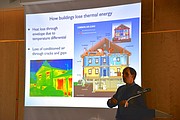Architect Peter Henry and seminar host and presenter Rich Taschler showed the differences between standard wall construction and the super-insulated double wall/staggered stud method of framing that conserves a homes energy using a few handy props. Photo by Andrea Worker.
The Rose Gallery at Reston Community Center at Lake Anne in Reston was the venue for a well-attended presentation by Rich and Marian Taschler on proper home insulation and its mostly unknown benefits. The program was offered under the auspices of Osher Lifelong Learning Institute (OLLI) at George Mason University. OLLI is a nonprofit organization founded to provide non-credit academic courses, special events and cultural activities for a mature adult membership, but the topic under discussion on Feb. 11 was of interest to any homeowner looking to lower those electric, gas and even water bills.
THE TASCHLERS are members of OLLI. Labeling themselves as “Those two ancient middle-aged teenagers,” the tandem bicycle riding couple from Burke bought a 2-year-old house in that area back in 1975. “That was in the days of the ’73 energy crunch,” Rich reminded the audience. “Energy prices were insane. Everyone was buying electric heaters as their solution. To me, that was addressing the effect. I wanted to go after the cause of heat loss in the house.” The main cause turns out to be inadequate insulation. “With the standard 2x6 studded wall construction method, so much of the heat in a house is lost, because wood conducts heat, and this method creates micro channels where the heat escapes,” explained Rich.
It took a lot of research and contact with experts from far afield – after all, Rich Taschler worked for the Department of Justice. He was a math major, not an engineer. But by 1976, the Taschlers were ready to start retrofitting their house. Over the course of seven years, working on 1 or 2 rooms each year, they removed the drywall and re-framed the rooms with the innovative “double wall with staggered studs” method. The result? When the project was completed in 1983, Rich Taschler switched off the furnace in his house – and immediately had a parade of Washington Gas technicians and supervisors coming to the door trying to figure out what was going on. And what did this major renovation cost? The Taschlers spent about $2,300 in materials, but were able to take a Federal tax deduction that brought the project cost to about $300.
In later years, the Taschlers wound up re-installing a furnace and AC unit. “You lose a lot of body heat that helps maintain the home’s temperature when the kids move out,” said Rich. “But even so, we could never find a unit small enough for our reduced energy needs. We went with the smallest apartment-sized units we could find.” Of course, the Taschlers continue to keep those utility bills to a minimum with their super-insulated home and now their solar hot water system that Rich designed and installed.
JOINING the Taschlers for this seminar was architect Peter Henry, who spoke about his designing of a certified “Passive Home” in Fairfax County. Henry took the audience through the evolution of home construction and spoke about the advances in energy efficiency being pioneered in Europe using the super-insulation concept and other technologies like heat recovery ventilation systems that virtually end the need for traditional heating and cooling systems.
The Taschlers and architect Henry stayed after the formal presentation to answer the questions of a number of attendees eager to learn more about how to super-insulate and cut those utility costs.
The Osher Lifelong Learning Institute offers classes and seminars like this one to their membership. Visit their website at olli.gmu.edu for more information.


